AG TIRE TALK KEY TAKEAWAYS
MAXAM: “The biggest driver of combine-harvester tire choices will be dictated by the type of crop and farming practices.”
Yokohama TWS: “Small grain crops stems are weaker reducing the possibility to damage the tires- Super Singles are the predominate choice of tires vs. a Dual Setup.”
BKT: “Super singles work well on combines in dry soil and have better flotation in moist and wet soil than duals.”
ASCENSO: “Generally speaking, if the correct field CFO air pressure is maintained with VF load tables on the largest dual fitment, then we believe Straddle Duals will make the case of the best overall option.”
MICHELIN: “The easiest way for producers to compare tires in regard to soil compaction is evaluating Field Air Pressure, choosing the product with lowest inflation pressure able to carry the load at the speed they are traveling.”
PRECISION INFLATION: “Soil compaction is directly related to tire air pressure; therefore, the lower the tire pressure, the lower the soil compaction: VF CFO+ provides the lowest air pressure and most flexibility.”
YOKOHAMA: “In most situations except very wet soils, properly inflated tires can deliver equivalent traction and minimize soil compaction just as well as tracks, while eliminating the extra weight, maintenance and expense of the bogie wheel assemblies required for tracks.”
Maxam Tire International
Greg W. Gilland: Vice President Global Agriculture
It is often argued amongst farmers and growers that the most important platform in their fleet of equipment is their combine-harvester. This is the vehicle that ultimately allows them to harvest their crop to sell in the market and achieve the sustainable business profits. Harvesters, whether owned or leased, tend to be the least used piece of equipment on a farm. Harvesters are typically the longest-lasting piece of equipment in terms of total hours of use as their wear and tear only occurs during the harvest, when comparing to the service or working hours experienced by tractors or self-propelled sprayers. In some instances, depending on the care or maintenance of the equipment, it can take up to ten years to consume the original factory mounted tires. The overall key market drivers for tires or tracks employed on a harvester are listed below:
- Farmers or growers own an estimated +88,000 combines from Class 6 to Class 10 harvesters in North America.
- Currently custom harvesters account for about 3000 to 5000 harvesters operating across both the US & CA.
- Combine harvesters are used for an average of 300 to 400 operating hours per year regardless of crop or application. Immediately after the harvest the vehicle is parked and prepared for the following season’s harvest.
- Load carrying capacity whether as a super single tire, dual fitment, or track solution.
- Ability of the tires to resist stubble or tread damage.
- Long-term tire or track wear rate to deliver longer product life or performance.
- Tire casing durability over the life or value of the tires.
- Ability to operate at lower tire pressure to increase flotation and to reduce overall soil compaction.
- Utilization of a track in heavy or wet soils to avoid rutting or creating soil waves as the tire transmits the torque.
- Ability to deliver traction and grip to lower machine slip resulting in increased productivity.
- Increased mobility with improved flotation and tread grip.
- Ability to travel over the field delivering the necessary footprint to avoid field rutting that can lead to greater ground compaction.
Ultimately it is the size of the farm, type of crop, and how the equipment is utilized or the inherent operational requirements that will determine the type of combine-harvester used, and the size or type of tires or tracks required. The biggest driver of combine-harvester tire choices will be dictated by the type of crop and farming practices. Below are some general guidelines that can help a farmer or grower determine what tires are most appropriate for his operation.
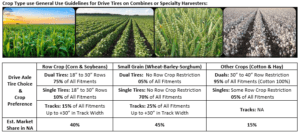
Note: Small Grains such as wheat are the single largest commodity crop traded worldwide.
Primary Applications Advantages for Dual Tires vs. Single Tires or Tracks
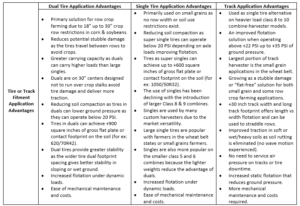
The introduction of VF tire technology with the additional 40% more load-carrying capacity per tire has helped to rewrite the load-carrying rules for either singles or duals. This technical advantage, without changing the tire sizing, is allowing OEMs to move to a new larger capacity, heavier, and increased powered combine harvesters to deliver the harvest faster. Although currently not in the AG track market as a manufacturer, MAXAM has aggressively adopted both the use of steel belts and VF technology to develop tire solutions that operate either as super single tires or as duals designed to carry heavier axle loads.
In the coming years, MAXAM will employ our new Ecopoint3 rubber compound technology to rewrite the tire endurance rules and deliver value-centered products that will exceed both OEM and farmer or grower expectations. An often-overlooked component in combine harvester applications is the growing tire loads, as stronger engine torque results in ground pressures being faced by the rear axle or steer tires that guide the vehicle. MAXAM’s steel belted AGRIXTRA H product range has been optimized to ensure that when applying the optimum air pressure, the tire tread contact patch can reduce the ground pressure or soil compaction without compromising the steering capability. Further, our VF tires are designed to deliver an optimized footprint at lower air pressures ensuring the best possible traction and flotation for any application.
Michelin Ag
David Graden: Operational Market Manager – Agriculture
This is an excellent topic! Often, I get asked this question by producers looking to minimize their down time during the harvest season, first and foremost. Second to that, they want to reduce their machine’s impact on the soil, especially in wet conditions.
Our answer for both of these questions, in addition to reducing fuel consumption, lowering maintenance, minimizing the total cost of ownership, and maximizing total efficiency is the Michelin CerexBib 2 VF CFO + in Dual Set Up.
Using this tire specifically designed for harvester application, I have seen some of the world’s largest combines harvest through standing water and saturated soils on a set of straddle dual VF 580/85R42 CerexBib 2 tires.
VF
With regard to the impact on the soil, these tires are VF (Very High Flexion) technology, which allows them to operate at 40% less air pressure than standard tires, or up to 40% more weight at the same air pressure as standard tires. This means they have a massive tractive capacity due to a larger footprint and, in turn, more lugs on the ground. As an added bonus, this large footprint significantly improves in-field fuel efficiency. As these tires work through the ground, they are able to roll over the soil instead of push through the soil, creating less resistance.
CFO
Tires are also rated for Cyclical Field Operation, or CFO, a 33% load bonus given to specially designed and constructed VF tires while that tire is being used in a “cyclical” condition and operating at or below 10 mph. “Cyclical” means that the load applied on the tire is constantly changing during the normal operation of the machine on which the tires are fitted; the tires are engineered and built to handle the fluctuating load, including when it spikes. The best example of this application is a combine with live load during harvest!
+
Tires are also rated CFO +, meaning they add another 9.5% to Cyclic Load for the Field.
In short, CFO + rating allows a producer operating at or below 10 mph to increase load under cyclical conditions by 42.5% over Standard VF Tire.
Duals vs Super Singles
Unfortunately, many folks think large single/floater tires always offer the best floatation. Where that may be true, in some cases, it doesn’t guarantee floatation and traction. In wet conditions, these wide tires can pack with mud and completely lose their tractive capacity. As these tires spin, they can create massive ruts, compact your soil and dig themselves into a hole, having a major negative impact on your yield for years to come.
Higher Air Pressure = More Soil Compaction
The easiest way for producers to compare tires in regard to soil compaction is evaluating Field Air Pressure, choosing the product with lowest inflation pressure able to carry the load at the speed they are traveling. Why?
Air pressure reductions equate to fewer Pounds per Square Inch transmitted to the soil. In other words, pressure to soil is a linear equation to Tire PSI, so as you reduce air pressure in the tire, you are reducing pressure to the soil and reducing soil compaction.
Below Study illustrates, comparing our CerexBib 2 VF CFO + tires to the competition:
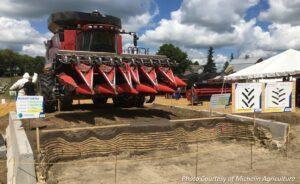

In summary, our answer to optimizing combine performance in all soil conditions is using a dual tire set up with the most advanced VF CFO + tires in the marketplace, specifically designed for the harvester application, providing the lowest air pressure (lowest soil compaction) able to carry the load at the application speed.
Yokohama TWS
Chris Neidert: AG Marketing, Training and Development Manager – North America
When looking at the US combine market needs and preference, we can divide them in two large groups based on the crop they harvest, and business model and it will explain the “why” of their choices.
Winter crops – Custom Harvesters
Many Custom Harvesters will harvest wheat and small grain. They start in Texas/Oklahoma and work their way all the way up to the border with Canada as the maturity of the crop moves north. Super singles is the predominate choice of tires vs. a dual setup. The main reason would be ease of transport from one customer’s field to the next, as most of these combines are transported on trucks and the outer duals would have to be dismounted requiring additional equipment to handle them. Small grain crops stems are weaker reducing the possibility to damage the tires. Popular sizes are 800 or 900 cross-sections that can handle the weight of most small grain headers.
Midwest Farmers
They will be mainly combining corn and soybeans. In general the farmer is the owner of the combine with possibly a Custom Harvester, but in a neighborhood area. Different as with small grains, corn and soybean maturity is more concentrated in time not allowing for custom harvesters to have a long harvest run. These combines are used most often times locally and not transported on trucks. Here a dual fitment is the setup of choice. Using duals, the grower will enjoy better lateral stability in the field and when roading the combine. Many times the header stays on the machine even when roading. This dual configuration provides additional load capacity for the combine, especially when fitted with corn headers that are heavier than a soybean header.
Most popular dual combine sizes vary between 520, 580 and 620 cross-sections.
Stubble Damage Possibly Reduced
Running duals will have less stubble damage because the tires can possibly go in between the rows and help minimize stubble damage. Super singles will have to travel over the stubble and additional stubble damage can occur.
Duals vs Singles
Usually a header on a wheat harvesting combine will be lighter and the single tire set up will be OK.
Corn or soybean headers are usually heavier, sometimes up to double the weight. Running a dual set up will be able to handle that additional weight on the front of the combine.
You know we can’t have a discussion about combine tires without talking about CFO and CHO technology.
CFO & CHO vs Standard Tires
CFO stands for Cyclical Field Operation. CFO, is a technology built into certain tires that allow for a temporary (cyclic) load bonus from the nominal load capacity. This load bonus is given to specially designed and constructed VF tires while that tire is being used in a cyclic loading condition and operating at harvest speed of 10 mph. Cyclic loading means that the load applied on the tire is in constant flux during the normal operation of the machine on which the tires are fitted. The tires are engineered and built to handle the fluctuating load. During harvest, the combine increases its weight when it’s filling up the grain bin. Once full ,this load is rapidly reduced when the grain bin is unloaded reducing the load on the tires and allowing it to cool down.
CHO stands for Cyclical Harvesting Operation. CHO, is a technology built into certain conventional (non VF tires) tires that allow for a load bonus from the nominal load capacity.
This technology follows the same usage concept to a CFO technology but deals with standard size tires. CHO engineering allows a standard tire to have up to an 80% temporary load bonus from the nominal load capacity.
The perfect and purest example of these applications is a combine during harvest.
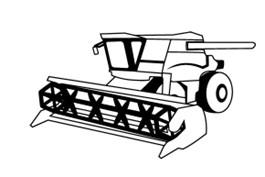
In the interest of time, let’s see how CHO technology will help handle the temporary overload condition vs a standard tire during harvesting. We’ll use an example of a typical combine tire size. 800/70R38. That tire is built in a standard size and a CHO size.
Let’s use an example of a common size combine that will be harvesting corn. The base weight of the combine is 41,778 lbs. We will add another 8,000 lbs. for the corn header. Since the combine has a 300-bushel hopper, during harvest when the hopper is full, that will add another 16,800 lbs.(300 bu x 56 lbs./bu) to the overall weight of the combine. Bringing that total to 66,578 lbs. We will use 80% of that weight is over the front axle. 66,578 x 80% = 53,262 lbs. /2 tires = 26,631 lbs. each tire will need to carry when the hopper is full.
We will refer to the below load tables. Our first tire will be our CHO tire. Using our above calculation that the tire has to carry 26,631 and we will use 6 mph CHO. As you can see that weight is between 23 psi and 29 psi. Doing some math, we will need to use 25 psi for the tire to carry the load at the 6 mph.
Here is where CHO technology really comes into play.
Using the same size tire but in a standard tire or non-CHO, you will not find that weight carrying capability anywhere in the tire’s load table. Therefore, using this tire in this particular load condition, that tire will be over-loaded during combining operations. Not acceptable.
Even if we were to try to get close, the most that standard tire could carry is 24,810 lbs. at 41 psi. The CHO tire will be able to handle that additional load and at 25 psi.
800/70R38 178D CHO

800/70R38 178D Standard

CFO & CHO Advantages:
- Bigger Footprint – Less Compaction & Higher Crop Yield
- Bigger Footprint – Better Traction
- Higher Load Capability – Longer Lasting Tire
Combine tires are an important part of your equipment. Ask your tire professional for advice.
Precision Inflation Systems
Ken Brodbeck: VP of Technology
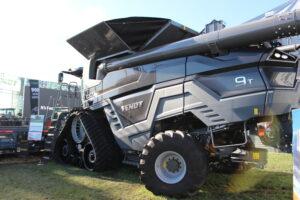
RUBBER TRACKS
Plus:
More flotation in mud
Narrower than tires
Minus:
$ 120,000 premium over tires
Can be rough ride on pavement
Heavier than tires
More maintenance on rollers & joints
Transport causes tracks to heat up

BIG SINGLE TIRES
Plus:
Only 2 tires to maintain
Faster road speed & run cooler than tracks
Lower cost than tracks
With tire inflation system, tire psi can be
lowered in muddy soils = more flotation
Minus:
More expense to replace than duals

DUAL TIRES
Plus:
If 1 tire damaged, lower replacement cost
Big duals more stable on hillsides
- Wider than Super Singles
Faster road speeds & cooler than tracks
Lower cost than tracks
With inflation system, tire psi can be
lowered in muddy soils = more flotation increased for transport
Minus:
4 tires to maintain rather than 2
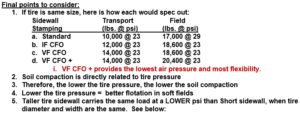
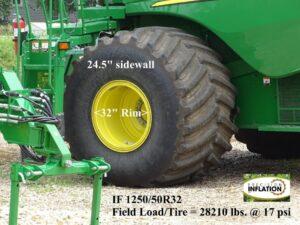

Ascenso Tires North America
Nick Phillippi
Recommending a fitment for a specific harvester is difficult from a 30,000-foot level, whether being a manufacturer or wholesale distributor. Then when you talk about all the variables to consider- soil types, moisture condition, stubble issues, transport width, tracking down the row, local tire dealer support, customer preference, and others it gets even tougher. Not only duals vs super singles vs tracks but what about tread type, tread depth, availability of product, and even the ROI?
At Ascenso we are developing tread designs that will provide better roading wear and ride; designs specific for use in snow, on hard surfaces, and in wet conditions. Ascenso is committed to building high-quality, high-value products but also being innovative where it makes sense for the end user- using more steel belting, building full width and height tires, unique tread designs and using VF technology.
But as far as recommendations, the best person to make this decision is ultimately the producer and the local tire professional in that area. They both know the details of that farm’s use and priorities, weather history, type of crops, and other key details. Sometimes the most innovative product simply doesn’t pay you back on the cost- if you are not able to get down to the lowest recommended field air pressure with standard tires there may not be a good reason to go to VF just for the sake of air pressure.
Certainly, the 4 application basics must be met – Load capacity, speed rating, size tolerances, and wheel fitment.
2nd set of parameters – Budget, length of time of ownership left, past problems to solve, satisfaction with current setup.
Best Low Soil Compaction Set-Up
Well, you can’t be out there in wet conditions, and you have to be able to adjust air if you want compaction to be a main talking point on any vehicle, including combines.
Generally speaking, if the correct field CFO air pressure is maintained with VF load tables on the largest dual fitment, then we believe Straddle Duals will make the case of the best overall option.
Until we have onboard air in agricultural equipment, we really can’t truly give the farmer the best in field and on-road performance. Lowering and raising pressure manually is just not an option that is practical in the real world.
BKT USA, Inc.
Dave Paulk: Manager Field Technical Services
Duals
Duals work well on combines in moist to dry conditions. Duals can help carry more load and help distribute that load over a wider area to minimize soil compaction with the correct air pressures. Combines and grain carts carry cyclic loads and can take advantage of IF-CFO and VF-CFO technologies that tires offer. This allows the tires to have more weight carrying capacity at slower speeds (field speeds) without changing air pressures. In wet conditions, duals are more likely to cause ruts and collect mud between the duals. In muddy conditions, it is necessary to keep the mud cleaned out between duals to decrease the possibly of stalks and rocks damaging the sidewalls of the tires. If the field is too wet, and ruts are deep, it takes some time to repair the soil from the compaction caused.
Super Singles
Super singles work well on combines in dry soil and have better flotation in moist and wet soil than duals. In moderately dry soil, super singles have a much wider footprint to distribute the weight of the machine and load and minimize soil compaction. Some super singles are IF or VF-CFO tires and can carry larger loads at slower speeds. Super singles do not cause ruts as bad or as deep as duals in wet and muddy soil. Depending on the type of soil, super singles may not clean out as well because of the width of the tires. If they don’t clean out as well as they should, similar to duals, they can become slick and lose traction. This could cause deeper rutting, damage to the soil from spinning, and possibly damage to the tire.
Tracks
Combines may have tracks, or a mixture of tracks on the front and tires on the rear for maneuverability and steering. In wet and muddy conditions, tracks seem to work well because of the width and length to distribute the weight of the machine and load over a much larger area. They provide good traction and good flotation. The track and undercarriage use dirt as a lubricant in the field, but needs to be checked occasionally for rocks, sticks, and stalks to minimize the possibility of damage by rocks and stalks. They can cause ruts in wet and muddy dirt, but generally not as extreme as duals. Since they are wider and longer, they float over the dirt better.
In moist and dry dirt, all three setups work well. With the right tires and air pressures, all three can be used to minimize soil compaction and provide good traction. When compaction can be neutralized, crop yields improve.
Roading
Pneumatic tires seem to wear better and smoother on the highway than tracks when moving between fields, especially with long distances. When roading distances are required, the crown of the road can cause some right-side tire wear. Because of the width of combines, they run at the edge of the road. This generally shows up in the smaller tires first because they turn more. The usable hours on tracks are shortened with a lot “roading” activity. Depending on the track setup and brand of undercarriage, tracks speeds can be a little slower while roading than a combine using tires.
Maintenance
On tractors with pneumatic tires, there is a tire, a wheel, and a hub. Although tires and wheels can be expensive when needing to be replaced, there isn’t much maintenance required. As long as the wheels are kept clean and the tires run at correct air pressure, they are usually problem free.
Tracks have many more moving parts. They have drive wheels on positive undercarriages, or guide wheels and idlers on friction undercarriages. Occasionally, the idlers need to be replaced. But more often, the mid-rollers wear out the fastest because they carry most of the weight. Tracks and the labor to install them are expensive. They must be aligned when tracks are replaced to prevent damage from the drive or guide lugs. They must be kept clean from rocks, sticks, and other debris getting into the drive lugs and cutting the inside of the belt. Tracks are somewhat more expensive to take care of but can provide good flotation in wet dirt and good traction in dry soil.
Condition Dependent
There are some differences between these three setups, but all can be used in the right conditions. In a perfect world, if no till or minimum till farming is used, it’s best to stay off the field in muddy conditions to minimize the possibility of compacting the soil. It takes a while to repair it once this is done. Unfortunately, it isn’t always possible to do this when a crop must be taken out. A farmer can use the setup to help them the most in these conditions.
Yokohama Off-Highway Tires America, Inc.
Blaine Cox: National Product Manager—Agriculture, Golf and Turf
There are a number of variables to consider when deciding between duals and large singles on combines, ranging from the size and capacity of the machine to the soil type, moisture levels, and even the width of local roads. In most situations except very wet soils, properly inflated tires can deliver equivalent traction and minimize soil compaction just as well as tracks, while eliminating the extra weight, maintenance and expense of the bogie wheel assemblies required for tracks.
Tires are also more fuel efficient than tracks, and are significantly better on the road—they ride smoother and last longer when roading compared to tracks.
Dual configurations can spread the load over a larger surface, which is obviously effective for reducing soil compaction force. However, if you are using the combine in gumbo, sticky mud or muck, the space between the duals can fill up with mud, reducing overall performance. Also, for many operators, the result can be a combine too wide for roading or even storage in some sheds, and, of course, more tires means more cost. As an alternative to duals, our Alliance Agriflex 372 IF (increased flexion) tire comes in a 1250/50R32 size that provides more than four feet of width on each tire for massive surface area in a single-tire configuration.
VF (very high flotation) tire technology has also dramatically changed farmers’ options when it comes to tire performance in combines. VF tires like the Alliance Agriflex+ series can operate at 40% less inflation pressure under the same load as conventional radials. In addition, farmers can select among a range of tread patterns to best suit their soils and conditions, providing greater flexibility than most track options.
High-capacity tires—in dual or single configurations—can be a high-performance, cost-efficient alternative to tracks. Since inflation pressure is such an important part of performance, it’s worth considering also investing in a central tire inflation system (CTIS), which allows the operator to adjust inflation pressure on the go. That ensures a low, compaction-minimizing inflation pressure on the field and a quick switch to a higher pressure for better roading. Optimizing inflation pressure ensures optimal performance, and can add significantly to tire life, making CTIS an investment that pays itself off very quickly.
Just as important as the tires is how you use the combine. If compaction is a concern, consider not filling up the grain tank—instead, offload grain sooner, while minimizing cart or semi traffic “shortcuts” across the field. Make sure your grain cart tires are also high-flotation, and that they are inflated properly to minimize compaction.
Finally, while combines, grain carts, and tractors get the most attention when it comes to soil compaction, it’s important to remember that every machine that touches the field can create or worsen soil compaction. At Yokohama Off-Highway Tires, we created the Whole Farm concept, a commitment to develop low-compaction tires for nearly any piece of equipment used in the field. The Whole Farm concept draws on our VF, IF and flotation tire technology to minimize soil compaction all year long.
Also, our Alliance 372 VF and IF rated harvester tires come with a CFO (cyclic field operations) rating. That allows for high cyclic loads while harvesting, which adds up to an additional 55% load at 10 mph or less and an additional 30% if you are running at 20 mph or less. That is an enormous amount of additional load capacity on a tire that is protecting the soil from excess compaction force.
All information is provided in this blog solely to provoke thought. All deductions made from information on this site must be confirmed by Certified Ag Tire Dealer before use. Ag Tire Talk does not recommend anyone conduct tire service work with exception of Certified Ag Tire Dealer Professionals.

